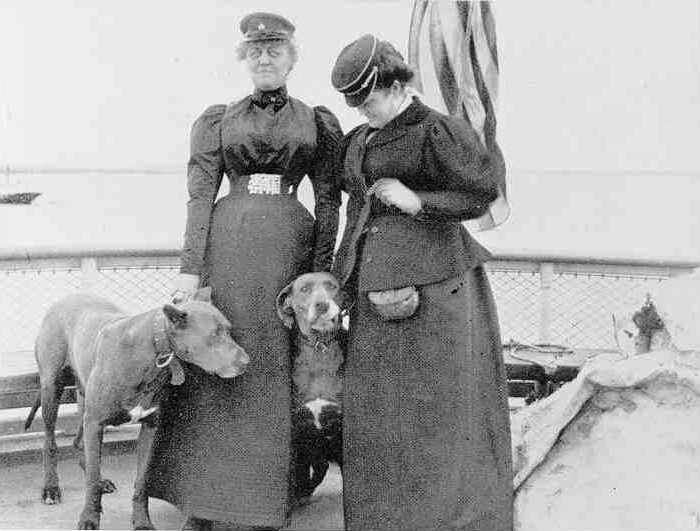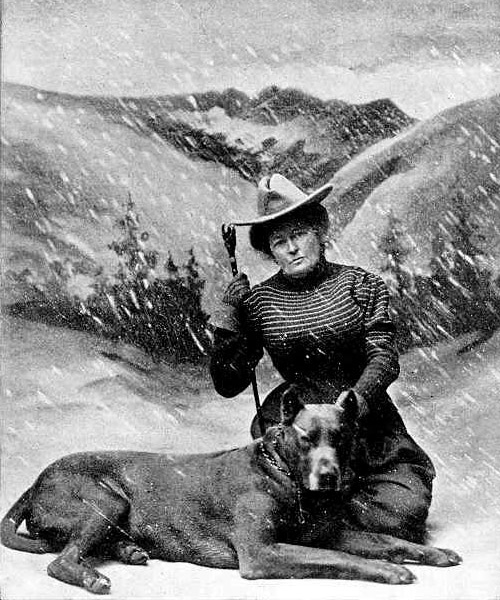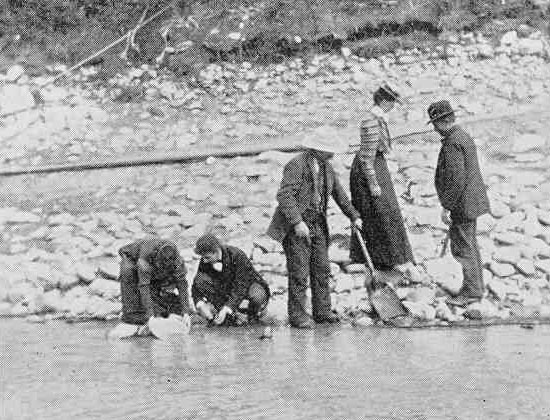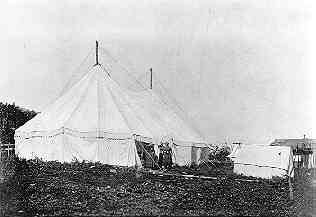
Photo from "Two Women in the Klondike" by Mary E. Hitchcock
Mary Hitchcock and Edith Van Buren helped usher in a new phase of the gold field's history. In 1898, while thousands were still struggling to reach the fields, this intrepid pair of adventurous women sailed up the Yukon into the Klondike as tourists.

Photo from "Two Women in the Klondike" by Mary E. Hitchcock
Hitchcock and Van Buren, whose previous tours had included China and Egypt, were no less electrified by "gold fever" than the rest of the world. Neither were they overly daunted by the dangers of a journey to the far north. Mary Hitchcock, the widow of a Naval officer, and Edith Van Buren, a great niece of former President Martin Van Buren, had both the financial resources and stamina for the journey, and were determined to do the Klondike in style. On June 12, 1898, they left San Francisco on the steamer St. Paul with their dogs, two canaries, a parrot, two dozen pigeons, fine linen and dishes, air mattresses, and books. Wanting to bring the comforts of home with them, the pair's luggage also included a graphphone and records, musical instruments, an ice-cream freezer, a portable bowling alley, a "beautiful acetylene light with which we intended to illuminate our tent," and an animatoscope and accompanying films.

Photo from "Two Women in the Klondike" by Mary E. Hitchcock
Not everyone was confident of the women's ability to make the trip. As Mary later wrote, the pair were considered "quite mad." In San Francisco, where they were interviewed before leaving, reporters asked if they really considered themselves ready to give up the luxuries of life to camp out in harsh conditions. The reporters evidently were not aware of either the pair's determination or their luxurious cargo.
The women did have some idea of where they were going and what might await them there. In her book, "Two Women in the Klondike," published in 1898, Mary Hitchcock explained why they did not take their maid on the journey. "We were sorry to leave her behind us, but the responsibility of taking a young and pretty girl into such regions as we had planned to explore would have been too great."
Tens of thousands of gold seekers arrived in Dawson in the summer of 1898, most of them sailing down the Yukon after climbing across the Chilkoot and White Passes. The stampeders who had set out for the gold fields during the winter of 1897/1898 had spent that winter encamped around Bennett and Lindeman Lakes, waiting for the Yukon ice to thaw before setting out for the gold fields in their hand-made boats.
It took most stampeders months of their lives and mile after mile of backbreaking work to haul their goods up to Dawson. But, only a few weeks after leaving San Francisco, Hitchcock and Van Buren, taking what was nicknamed "the rich man's route" steamed into Dawson with their crates and animals (minus Ivan, who had been sent home by his owner, Edith, who had begun to fear for his safety among the more "uncivilized" Klondike dogs). By the time they arrived, the little town near the gold fields had exploded from a few thousand to over 30,000 people.
"The three long wharves are so packed with people that we expect to see them precipitated into the water by the addition of a feather's weight. Miles and miles of tents of all sizes and descriptions fill the town, and are pitched everywhere on the hillside. Skeletons of many warehouses which are being constructed and a few log cabins are also to be seen. Stores of all kinds line the main street and river-front, some being less than ten feet wide, as rent for ground is ten dollars a foot per month, we are told, in this business part of the town. From the landing up to the Klondike River, boats of every style line the water-front, reminding one of the house-boats about Canton, although those belonging to this settlement are of a much more primitive character."

Photo from "Two Women in the Klondike" by Mary E. Hitchcock, 1899
Their first day in town, Hitchcock and Van Buren were guests at Belinda Mulrooney's new hotel, the Fair View. The day after their arrival, the pair set out for the post office to retrieve their mail. Instead of the dozens of letters, books and magazines they were expecting, they found only one letter. "We sent for the postmaster, who . . . politely explained that a very small mail had been sent in over the pass, but that the greater quantity would come by the [steamer] Alliance according to contract made by our Government. First disappointment."
The tourists decided to pitch their tent across the Yukon River at was known as "west Dawson." This area was not as crowded as Dawson City, which was critical because the pair needed extra space for their tent. In order to house all that they had brought, and leave room to move comfortably about, Hitchcock and Van Buren had purchased a tent that measured 40 x 70 feet, and weighed over 400 pounds. It stood out easily among the more ordinary tents dotting the landscape. Once a crew of men had been engaged to put up the tent, it immediately became a center of attention. Instead of planking the ground inside, as they had intended, the pair enjoyed the picturesque wild flowers and plants, which made the place look "so picturesque" that they could not bear to destroy it.
The Klondike Nugget reported on the pair, calling them the latest additions to Dawson society. "The ladies are wealthy and are very well known in the United States. They travel for pleasure, and are simply 'doing' the Klondike country."

Photo from "Two Women in the Klondike" by Mary E. Hitchcock, 1899
Hitchcock and Van Buren had the air mattresses unpacked, but the air-pumps which were to have accompanied them could not be found. The pair tried to blow up the mattresses themselves, but laughed too hard at the situation to do any good and set up the hammocks instead. The women hired an unemployed miner named Isaac as their cook. The match was a continuing strain to both parties and after several weeks, Isaac left them to fend for themselves.
The tent soon proved to be a disappointment. The poles used to erect it were too short and countless numbers of sagging pockets appeared, holding and dripping water. One evening when they returned, they found the tent "almost collapsed from wind and rain," but noted that "it is always easy to find a dry place, owing to its enormous size."
More disappointments followed. When the pair were able to open up the rest of their luggage, they discovered that the trunks had gotten wet and many of their clothes were ruined. The pigeons also quickly became intolerable. Instead of returning only to a specially constructed pigeon cote, they made themselves at home throughout the tent, resting on desks while the women were trying to write, setting off the graphphone, "causing the greatest amount of trouble. . . . Nothing will induce them to leave the tent." Despite its defects, the pair did find the tent useful for public religious services during their stay.
In August, the women finally made a trek out into the gold fields. The trip lasted several days, with both women walking mile after mile over rough ground. Among the cabins they stopped at was the home of Clarence and Ethel Berry. The Berry family was among the earliest to mine in the area.
Mary Hitchcock and Edith Van Buren were not the first drawn to the Klondike as tourists after the great gold strike, but Hitchcock's book, published on their return, was widely read and made the pair the best known early sightseers. When his family wrote that they were reading Hitchcock's book, one stampeder, Israel Herbert Lee, wrote back. "I knew them very well," he said, "and remember the big tent and the pigeons."
